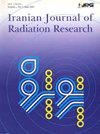乳腺癌患者的累积辐射暴露剂量诊断成像研究
Q4 Health Professions
引用次数: 5
摘要
背景:乳腺癌是放射肿瘤学中一种常见疾病。我们评估了乳腺癌患者接受的辐射剂量,这是一个经常被忽视的问题。材料与方法:将101例乳腺癌患者从首次就诊至放疗开始的单项诊断性影像学检查有效剂量相加,计算总有效辐射剂量。利用组织加权因子和剂量-长度乘积估算普通放射照相和计算机断层扫描(CT)的有效剂量。同位素(18f -氟脱氧葡萄糖和99m tc -二膦酸亚甲基)的有效剂量是利用剂量系数从每种同位素的放射性中估计出来的。利用图像存档与通信系统中的放射记录分析患者的辐射暴露情况。结果:从初始成像到开始放疗的中位时间为4.5个月(范围:0.7-13.4个月)。对比各诊断方式的平均有效剂量,CT、正电子发射断层扫描-CT、骨扫描和x线摄影分别占总有效剂量的64%、21%、10%和5%。根据临床因素(年龄、AJCC分期、T分期、N分期、手术方式、肿瘤部位)比较总有效剂量的多因素分析显示,只有T分期与总有效剂量显著相关(p = 0.004)。总有效剂量中位数为71.5毫西弗(范围:11.9-131.9毫西弗)。结论:乳腺癌患者在诊断检测中接受的辐射剂量不可忽略。我们需要系统地收集和管理患者从医疗程序中接受的剂量。本文章由计算机程序翻译,如有差异,请以英文原文为准。
Cumulative radiation exposure dose of diagnostic imaging studies in breast cancer patients
Background: Breast cancer is a common disease in radiation oncology. We evaluated the radiation dose received by breast cancer patients, an oftenneglected concern. Materials and Methods: The total effective radiation dose in 101 breast cancer patients was calculated by summing the effective doses of individual diagnostic imaging tests from the first hospital visit to the initiation of radiotherapy. The effective dose from general radiography and computed tomography (CT) was estimated using tissue-weighting factors and dose-length products. The effective dose from isotopes (18F-fluorodeoxyglucose and 99m Tc-methylene diphosphonate) was estimated from the radioactivity of each isotope using dose coefficients. The patient radiation exposures were analyzed using radiologic records in the Picture Archiving and Communication System. Results: The median duration from initial imaging to the initiation of radiotherapy was 4.5 months (range: 0.7–13.4 months). When comparing the average effective doses associated with each diagnostic modality, CT, positron emission tomography-CT, bone scanning and radiography occupied 64%, 21%, 10% and 5% of the total effective dose, respectively. Comparison of the total effective dose according to clinical factors (age, AJCC stage, T stage, N stage, operation method, and cancer location) by multivariate analysis revealed that only T stage was significantly correlated with the total effective dose (p = 0.004). The median total effective dose was 71.5 mSv (range: 11.9–131.9 mSv). Conclusion: The radiation dose received from diagnostic testing in breast cancer patients is not negligible. We need to systematically collect and manage the doses received by patients from medical procedures.
求助全文
通过发布文献求助,成功后即可免费获取论文全文。
去求助
来源期刊

Iranian Journal of Radiation Research
RADIOLOGY, NUCLEAR MEDICINE & MEDICAL IMAGING-
CiteScore
0.67
自引率
0.00%
发文量
0
审稿时长
>12 weeks
期刊介绍:
Iranian Journal of Radiation Research (IJRR) publishes original scientific research and clinical investigations related to radiation oncology, radiation biology, and Medical and health physics. The clinical studies submitted for publication include experimental studies of combined modality treatment, especially chemoradiotherapy approaches, and relevant innovations in hyperthermia, brachytherapy, high LET irradiation, nuclear medicine, dosimetry, tumor imaging, radiation treatment planning, radiosensitizers, and radioprotectors. All manuscripts must pass stringent peer-review and only papers that are rated of high scientific quality are accepted.
 求助内容:
求助内容: 应助结果提醒方式:
应助结果提醒方式:


